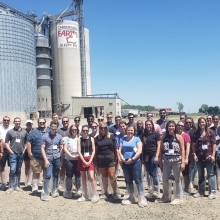How is COVID-19 impacting Minnesota's pork industry?
COVID-19 has greatly impacted Minnesota’s food industry. Minnesota Chamber President Doug Loon interviewed those who work closely in the pork industry – from the Minnesota Pork Board and Christensen Farms – to better understand how this critical sector has persevered to continue to provide a high-quality product, despite COVID-19 challenges.

DOUG LOON: Coronavirus has caused a disruption in meat packing and distribution. What does that kind of disruption mean for Minnesota, specifically?

DAVID PREISLER, CEO MINNESOTA PORK PRODUCERS ASSOCIATION: There are a lot of factors at play in why the disruption in packing plants has had such an impact on Minnesota. Our food supply chain is a complex system that was built to safely and efficiently move raw products into the market. Consumers are accustomed to always having an abundant, fresh, and affordable supply of food. In order to meet that demand, the supply chain has to be able to operate in a way that fresh product is always moving. One disruption at a plant would have a negative impact on almost all farms, but there is some room to make adjustments. With many packing plants closing or operating at reduced capacity, the supply chain experienced a huge blow, nothing like we’ve ever seen before. Much like the novel coronavirus that caused COVID-19, this was a novel challenge to our supply chain.
Did you know?
-
If you buy pork at the grocery store, a local butcher shop, or a restaurant in Minnesota, there’s a very good chance that pork came from a pig that was raised by a Minnesota farmer.
-
Minnesota is the number two producer of pigs in the country.
-
In 2019, Minnesota’s pig farmers sent 17.3 million pigs to market worth almost $2.5 billion in sales.
-
Last year, Minnesota pig farmers produced almost 10.7 billion servings of pork (10,699,943,880).
-
While Minnesota raises 17.3 million pigs, more than half of them leave the state for processing.
-
There are five primary packing plants where Minnesota pigs go for processing, JBS in Worthington, Minn, Hormel in Austin, Minn., Smithfield in Sioux Falls, SD, Tyson in Storm Lake Iowa, and Tyson in Waterloo, Iowa.
Current information on the status of U.S. pork processing plants can be found here.

DOUG LOON: It seems like processing plants are experiencing challenges with COVID among the workforce. How is this being handled?

DAVID PREISLER, MINNESOTA PORK: Meat processing plants across the United States (pork, beef and chicken) have slowed down or closed due to availability of workers. This is a result of positive cases of COVID-19 within the employees working at the plant, as well as healthy employees who do not come to work fearing they will become ill. Packing plants are collaborating with workers to ensure the health and safety while working to supply grocery stores and food shelves across the United States.

DOUG LOON: All employers are taking steps to protect employees. What have plants done to stop the spread of infection between employees?

DAVID PREISLER, MINNESOTA PORK: While every plant is unique in the age, design and capabilities, several proactive steps above and beyond the required Sanitation Standard Operating Procedures (Sanitation SOP) have been implemented to help protect the health and safety of employees. This includes thoroughly cleaning and sanitizing work areas throughout the plant daily, providing face covers for all team members, providing face shields where distancing is not possible, installing plexi-glass dividers to enhance social distancing during breaks and implementing a number of other policies and procedures to mitigate risks for employees.

DOUG LOON: Can COVID-19 infect pork?

DAVID PREISLER, MINNESOTA PORK: Studies have shown that COVID-19 does not infect pigs and does not infect pork. Pork is safe to eat. The ideal temperature to cook pork to is 145o and let it rest for five minutes.


DOUG LOON: Farmers are important contributors to our economy. How are they impacted by this?

DAVID PREISLER, MINNESOTA PORK: COVID has impacted every one of Minnesota’s pig farms, no matter their size or location across the state. The current backlog of pigs because of earlier packing plant disruptions will take months to work through. This is a particularly stressful situation for farmers who work to take care of the people, their pigs, and their community. There is also a serious financial strain on their businesses as the market continues to adjust and adapt. The situation changes day-to-day and farmers will have to be resilient to survive. There will be some multi-generations family farms that won’t survive and that’s a real tragedy, not just for their family businesses, but for rural communities and Minnesota. Farmers have been, and remain focused on providing the best possible care for their pigs and doing everything possible to bring safe, nutritious pork to the food supply chain. To accomplish this, farmers make sure all pigs are able to access food and water, have the ability to lie down and receive the proper medical attention if needed.
As an absolute last resort, with extended disruption in the processing plants, farmers will be forced to depopulate market ready pigs. Additionally, long term loss of processing capacity in the U.S. is expected as plants implement changes to enhance worker health and safety in the plants. Farmers have been, and remain focused on providing the best possible care for their pigs and doing everything possible to bring safe, nutritious pork to the food supply chain. To accomplish this, farmers make sure all pigs are able to access food and water, have the ability to lie down and receive the proper medical attention if needed.

DOUG LOON: That’s a tough issue to face. I assume other options have been considered?

DAVID PREISLER, MINNESOTA PORK: Yes, of course. Unfortunately, it’s not possible to keep them in barns longer because the interruption at processing plants has caused the number and size of pigs in the barns has reached a critical point. When pigs get too crowded, they are not able to access proper feed and water. As a result, they become aggressive and injure each other as they compete for food and water.
Moving market-ready pigs to the outdoors to wait until packing plants begin to ramp up operations will not prevent the issue of the animals becoming too large for the packing plants infrastructure and what they are able to actually handle for animal weight. Obviously the industry understands limitations of other indoor housing for critical reasons, mostly focused on keeping the animals safe.
Our mission is to produce food, so the thought of all our hard work, care and investment going to waste is beyond comprehension. We are talking with local meat lockers to understand who has capacity to take a small portion of our hogs. Most local meat lockers don’t have capacity and are scheduled out weeks to months in advance.

GLENN STOLT, CHRISTENSEN FARMS: Local meat lockers currently don’t have capacity for harvest of these pigs. Relocating the animals until the packing plants come back online does not prevent the issue of the animals becoming too large for the packing plants and what they are able to handle for animal weight.
Many farms, Christensen Farms included, has worked with employees and contract partners to donate and harvest several thousand pigs. Being part of the fabric of a small, rural community and recognizing the hardships faced in rural farming communities across the Midwest, the company asked for no payment, but rather to make a pork or monetary donation in local communities to food shelves, emergency service providers or to a family in need. To date, approximately $50,000 has been donated within towns across Minnesota. In addition to the market-ready hogs provided to contract partners, Christensen Farms arranged harvest at a local meat locker near Clements, Minnesota, allowing over 60 of the company’s employees to receive a whole hog donated by Christensen Farms.

DOUG LOON: When will consumers be able to buy their preferred meat products again and will they be more expensive?

GLENN STOLT, CHRISTENSEN FARMS: We don’t know, but we will find out more as processing plants are allowed to reopen. We’re just learning what new processing capacities will be with the worker health and safety provisions within the plants. We don’t know how many farmers will be forced to liquidate their herds and go out of business. We are accustomed to abundance and choice in our grocery stores, and COVID-19 has certainly changed that.
As we look back at the history of agriculture, there are disruptors that change the way it happens. There are good disruptors like technology, a wealthier society with elevated expectations and choice, and there can be bad disruptors like war, economic collapse and crisis like the 1980’s, human disease like the Spanish flu in the 1920s. COVID-19 will leave a permanent mark on agriculture, as it will so many other businesses. Years from now when the next generations ask why farming is the way it is, COVID-19 will be an inflection point. People need to eat, and agriculture will sustain. We don’t know exactly what it will look like, we just know it will be different. The one thing that won’t change is farmers’ commitment to their purpose, their teams of employees and partners, their communities, their animals and the environment.
The next time you go to the grocery store to pick up your bacon, pork chops or ribs; take a moment to reflect on the passion and purpose filled life of the farmer who helped get it there.
LEARN MORE: PORK INDUSTRY FINANCIALS
Pork is a commodity business, and farmers are not able to pass along costs to consumers to maintain a margin. Farmers have to pay what the market demands for the feed to raise the pigs (approximately 60% of the cost of production), and farmers have to take what the market will give them for the pig they raised. Right now, for each hog sold for harvest, pork producers lose $35-$40 per pig. If pigs are depopulated and disposed of never entering the food supply chain, producers lose the entire investment into the pig, approximately $145 per pig plus $30 per head to pay for disposal, bringing the total loss to producers to $175 per pig.
Without meaningful financial support, the pork infrastructure is at risk of unraveling. If breeding herds are liquidated, workers will be laid off and contracts for production will be cancelled. The downstream impact on agriculture will be significant. Contract farmers relying on those consistent checks will default on their barn payments and will be denied access to working capital for diversified operations. With roughly one-third of grain farmers’ production destined for livestock feed, compounding the ethanol market loss, a collapse in production in the pork industry will further impair the viability of the grain production sector, and as a result, our consumers and the nation’s food supply will suffer.


